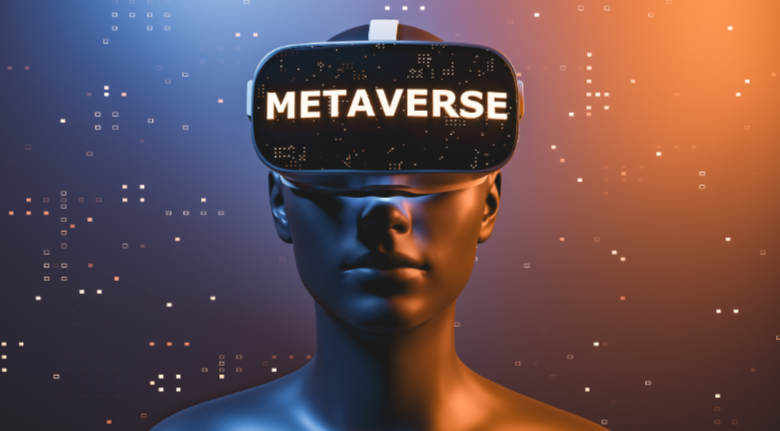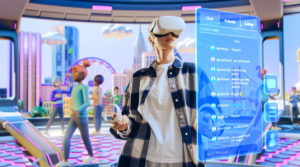What is the Metaverse? An 5 plus Explanation and In-Depth Guide

Welcome to the world of the Metaverse. It’s a digital realm where reality and life mix. It offers endless possibilities and guests. In this composition, we’ll dig into the meat of the Metaverse. We’ll explore its description, literal roots, and coming arguments. Join us on this trip. We will uncover the fascinating. We will see its hidden impact on society and business. Let’s embark on a discourse about offensive digital geography together.
Defining the Metaverse: What Is It Exactly?
The Metaverse is exciting. It represents the next step in social connection. Let’s dive into what it entails:
- Definition:
- The Metaverse is a massively scalable, persistent network of integrated virtual worlds. It is made for people to work together. They use it to work, socialize, do business, play, and even create.
- It leverages advanced technologies such as augmented reality (AR), virtual reality (VR), and haptic sensors to fully immerse users in these digital realms.
- What It Offers:
- Social Connection: Like the internet, the Metaverse lets you connect with others. It works even when you’re not in the same place. It aims to bring us closer to the feeling of being together in person.
- Activities in the Metaverse:
- Connect: Instead of video calling on a 2D screen, imagine meeting friends at a virtual concert.
- Learn: how to teleport to any time or place. Use it to witness history or explore planets.
- Shop: Step into spaces that embody your favourite brands. Attend global launch events and buy physical and digital products.
- Work: Picture joining a remote meeting where everyone sits around a virtual table.
- Play: Engage in games using holograms, like playing chess with a friend across the world.
- Accessing the Metaverse:
- The Metaverse includes familiar 2D experiences. It also has ones projected into the physical world and fully immersive 3D spaces.
- You can access it via devices like your phone, computer, or virtual reality headsets.
- Who Is It For?:
- The Metaverse isn’t limited to gamers or developers; it’s for everyone.
- The hope is that within the next decade, it will reach a billion people.
The Evolution of the Metaverse: A Historical Perspective

The idea of the Metaverse comes from fiction and early virtual reality trials. In the 1980s, author Neal Stephenson made the term” Metaverse” popular in his novel” Snow Crash.” He described it as a virtual space. There, druggies could interact with each other and digital things.
Still, the idea of a fully immersive digital world took shape in the early 1990s. This was with virtual worlds like Second Life. Also, with online role-playing games (MMORPGs) like Ultima Online and World of Warcraft. These platforms let stoners create virtual people and explore digital places. They also let them hang out in real time. In the early 2000s, there were more advances in video reality tech. New products, like the Oculus Rift and HTC Vive, led to immersive experiences. They were also interactive. Also, Facebook and Twitter made new ways for virtual socialization and messaging.
The public sees Facebook’s (now Meta) 2014 acquisition as a big move into tech. They bought Oculus VR. This shift showed a big investment in evolving virtual reality. It also showed belief in creating a unified digital world. In this world, stoners could easily interact and share.
Recently, the Metaverse has drawn much attention. This attention comes from tech giants, gaming companies, and investors. Companies like Epic Games make Fortnite. They have been exploring the mix of virtual worlds and gaming tricks. Platforms like Decentraland and The Sandbox are adding detailed, blockchain-powered virtual worlds.
As we look to the future, the Metaverse will keep growing. It will be driven by advances in virtual and stoked reality, AI, and blockchain. It spans virtual conferences and digital workplaces. It also covers immersive entertainment and virtual husbandry. The Metaverse holds the promise of reshaping how we live, work, and play in digital time.
Key Differences Between the Metaverse and the Internet
The Metaverse and the internet are both digital realms. They grease connectivity and commerce. But, there are several key differences between them.
The internet has two-dimensional trap runners and static content. But, the Metaverse is different. It offers a more immersive and interactive experience. Stoners can move in 3D virtual spaces. They can interact with digital objects and enjoy real-time socializing.
In the Metaverse, druggies often have patient digital identities. These are in the form of avatars or virtual representations of themselves. These features can be customized and proven. They let druggies express themselves in unique ways. The internet generally relies on usernames and biographies. But, they may not be as visual or customizable.
The Metaverse is organized spatially. It has virtual surroundings that druggies can explore and interact with in a 3D space. This spatial link lets further immersion. It’s like virtual events, conferences, and real estate tours. The internet is disorganized. It is organized mainly through links and search. The information is presented directly and spatially.
The Metaverse has a virtual economy. Here, people can buy, sell, and trade digital money and goods. This virtual thrift is often powered by blockchain technology and fungible commemoratives (NFTs). They allow for the use and transfer of unique digital items like virtual real estate, artwork, and collectables. The internet has eased e-commerce and online deals. But, the Metaverse introduces new ways to make money and create value in virtual spaces.
The Metaverse is big on social commerce and community-structure. It has virtual spaces to enable real-time communication and collaboration among druggies. These events can be virtual. They can include meetups, musicals, gaming, and conferences. The internet enables social commerce on social media and forums. But, the Metaverse offers a more immersive terrain for connecting with others.
The Internet and the Metaverse are alike in connectivity and communication. But, the Metaverse adds new limits on absorption. It limits identity, space, thrift, and social commerce. These limits separate it from the internet.
The Role of NFTs and Cryptocurrency in Shaping the Metaverse
NFTs and cryptocurrency are vital in the changing Metaverse. They are vital in shaping its geography. NFTs are special digital items. They are stored on blockchain technology. They define power and failure in virtual worlds. In the Metaverse, druggies can make, buy, and sell digital goods and get. NFTs enable the power and trading of digital art, virtual real estate, in-game items, and more. They help grow a lively economy in these virtual worlds. Cryptocurrency helps perfect deals in the Metaverse. It offers a decentralized way to switch value across virtual platforms. NFTs and cryptocurrency are revolutionizing how we interact with digital content. They are also fixing the origins of a decentralized and immersive digital offering.
Accessing the Metaverse: Exploring Entry Points and Platforms

Likewise, VR platforms like VRChat and Rec Room are gregarious. They offer immersive spaces for gregarious commerce within the Metaverse. They let druggies connect with others. They do this through customizable incorporations and by participating in virtual gets. Platforms like CryptoVoxels and Somnium Space are decentralized. They offer virtual halls and have druggies to make and sell digital creations. This furthers a decentralized economy in the Metaverse. The Metaverse is growing. Finding its entry points and platforms is key for individuals who want to fascinate with this new digital world. Doing this is key to unlocking its full potential for originality, socializing, and making money.
Major Brands’ Involvement in the Metaverse: Opportunities and Challenges
Interest in the metaverse is growing. Major brands are looking for ways to be there. The metaverse is a digital world where individuals can interact, work, and play in immersive spaces. Brands see a chance to charm consumers there in new ways. The metaverse offers a lot for companies. It has virtual storefronts, events, and ads. These let firms connect with their prey followership on a deeper level. This furthers brand loyalty and drives sales.
But, there are also big complaints for brands entering the metaverse. One big problem is icing reality. It’s about preserving brand truth in virtual places. There, the lines between reality and lies blur. Also, tricky tech conditions pose fresh hurdles. These include data hiding and screening, and dealing with nonsupervisory enterprises. Despite these protests. brave brands are embracing the metaverse as a frontier for invention. They are investing to set up a meaningful presence, ready to profit from its vast future in the digital age.
Implications for Gen Z: Advertising and Marketing Strategies
The Metaverse’s emergence has steered into a new era of ads and marketing. This is especially true for engaging with Generation Z (Gen Z). Gen Z are digital natives. They are used to immersive and interactive digital things. So, the Metaverse is a natural fit for them. Brands targeting Gen Z must understand this demographic cohort’s special qualities. These include their focus on reality, personalization, and community. In the Metaverse, ads and marketing should focus on immersive brand experiences. These should resonate with Gen Z’s desire for real connections. This can be done with virtual events and games. It also requires virtual spaces. These should cater to Gen Z’s digital skill and love for proven content.
Brands must also grasp translucency. They must do this when speaking to Gen Z in the Metaverse. This group values brands that are genuine and transparent in their relations. They want honesty and truth in ads and marketing. By building trust with Gen Z, brands can fascinate them and form lasting connections within the Metaverse. Also, using content made by stoners and co-creation can boost brand engagement with Gen Z. It lets them share in the innovation and make the virtual stuff they like. Gathering the Metaverse’s counter accusations is crucial for brands. They must adjust their advertising to connect with Gen Z. They are a digitally native group in the changing digital world.
The Metaverse in Business: Virtual Conferences, Workplaces, and Beyond
The idea of the Metaverse is quickly reshaping traditional business practices. It offers clever results for virtual conferences, digital workplaces, and more. Virtual conferences are hosted in the Metaverse. They give companies a chance to connect with global culture. The culture is immersive and interactive. Attendees can share in keynote addresses, shops, and networking sessions, all from the comfort of their own homes. Using virtual conferencing in the Metaverse, companies can cut the costs of travel and meetings. They can also give attendees special and memorable events that boost engagement and collaboration.
Also, giving up virtual Metaverse offices is revolutionizing how companies operate online. These virtual places pretend to be physical department spaces. They come with virtual services, gathering areas, and tools for collaboration. workers can seamlessly give and unite in real- time, anyhow of their geographic position. Virtual workplaces in the Metaverse boost productivity and effectiveness. They also give workers more flexibility and autonomy. Companies continue to explore the Metaverse. It will integrate virtual conferences, digital workplaces, and other clever operations. These changes will shape the future of work and business missions.
The Metaverse’s emergence is a transformative change. It affects how companies fascinate consumers and operate online. The Metaverse has many openings for companies. They can use it to reach and connect with fans in new and creative ways. It includes virtual conferences, digital workplaces, and immersive brand events. Brands that embrace the Metaverse can create deeper connections. They can also boost engagement and stay ahead in a shrinking market.
Avoiding the complexities of the Metaverse requires thinking about technology, stoner choices, and ethics. Brands must put truth first. They must also be clear and have stoner experience. This is what it takes to succeed in the virtual world. The Metaverse is evolving. Companies that adapt and innovate will thrive in this vivid digital terrain. It suits the future of commerce, messaging, and consumer engagement.
Conclusion
The rise of the Metaverse is a big change. It transforms how businesses engage with consumers and operate online. The offers many opportunities for businesses. They include virtual conferences, digital workplaces, and immersive brand experiences. These new ways to connect with audiences let businesses innovate. By embracing the Metaverse, brands can foster deeper connections. They can drive engagement and stay ahead in a competitive landscape.
Also read https://magazinehint.com/what-is-virtualization-technology/




One Comment